Americans are preoccupied with crime, and convinced that it’s always getting worse. On one hand, they’re fascinated by criminals and their lifestyles, often glamorized by Hollywood and the media. On the other, they live in terror that criminals present a growing threat to order, peace and prosperity — a fear so pervasive that it shapes elections and defies the statistical reality that crime has been declining since 1991. What can we learn about that gap? Here’s the breakdown.
1,000,000 copies
That was the circulation of the New York Daily News, America’s first crime-obsessed tabloid, when it became the top-selling newspaper in 1926. Prohibition, bootlegging and organized crime made mafiosi like Al Capone household names. True Detective became the first true crime magazine in the 1930s, reaching more than two million readers. The Depression saw homicides surge, while celebrity bank robbers like Ma Barker and “Pretty Boy” Floyd became famous on the radio.
Flawed stats since 1930
The FBI started compiling nationwide crime data under Director J. Edgar Hoover, who would become one of Washington’s most powerful people. Uniform Crime Reporting still relies on the disparate numbers volunteered each year by 16,675 different agencies — federal, state and local. Critics question their consistency, reliability and timeliness. The Real-Time Crime Index is a private alternative that makes monthly projections based on samples rather than comprehensive data.

8,000 pages of notes
Truman Capote did extensive research to write the first true crime novel, recounting a killing in rural Kansas and the murderers’ eventual punishment. Published in 1966, “In Cold Blood” has sold millions of copies. In 1967, the hit film “Bonnie and Clyde,” about a couple who robbed banks together, helped spawn the “New Hollywood” movement, which would produce numerous crime movies inspired by real life, like “Chinatown” and “The Godfather.”
716 violent crimes
That was the rate per 100,000 people in 1991. In 2024, that number was 359, or roughly half — though still one every 25.9 seconds. All crime has declined since 1991, with a brief exception during the Covid-19 pandemic. Property crime declined 8% in 2024 to its lowest level since 1961. The murder rate that year fell 15% nationwide and 33% in St. Louis — America’s “murder capital.”

64% pessimistic
Two-thirds of Americans in 2024 believed crime had increased nationwide, while 49% felt the same about their own neighborhoods. Perception is also related to political affiliation: 90% of Republicans believed that crime was rising nationwide, compared to just 29% of Democrats. In that year’s election, 76% of Donald Trump supporters cited violent crime as an important issue in their voting decision, as opposed to just 46% of Kamala Harris supporters.
Perception is shaped not by numbers and data, but by two things: what people feel and see when they go outside, and what people hear and read on the news. -Council on Criminal Justice Vice President Insha Rahman
84% of Americans
That’s how many over age 13 consumed true crime books, docuseries or other content last year. In podcasts alone, this market is worth $2.3 billion, reaching 42 million Americans each month. One third of U.S. podcast listeners choose true crime shows, including 44% of women — and 57% among women with a high school education or less. “Crime Junkie” is the country’s second-most popular podcast, with two billion downloads.
Tech crime uptick
Cryptocurrency fraud grew by 66% in 2024, costing Americans $9.3 billion. The U.S. reports the most crypto-related kidnappings in the world since 2014, known as “wrench attacks” for using real-world violence to obtain digital assets. Deloitte forecasts that by 2027, generative AI could enable malign actors to net $40 billion in fraud. People over 60 filed the most internet crime complaints last year.
This story appears in the November 2025 issue of Deseret Magazine. Learn more about how to subscribe.


